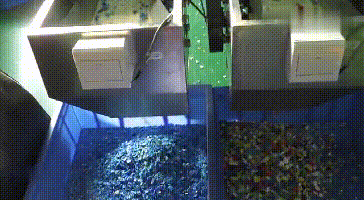Plastic Type-based Sorting
Plastic type-based sorting entails the automated categorization of plastic materials based on their composition and material types. Utilizing advanced sensor technologies and sorting algorithms, plastics are sorted into different categories, enabling efficient recycling processes. This sorting method maximizes material recovery rates, reduces waste, and promotes the sustainable reuse of plastic materials based on their material types.
Plastic Type-based Sorting Machine

Introduction
Plastic type-based sorting machines are advanced technologies designed to optimize the recycling process for plastic based on material type attributes. These machines play a pivotal role in improving the efficiency and sustainability of waste management practices, particularly in the context of plastic type-based recycling. With the escalating global concern over plastic pollution and the increasing demand for recycled materials, the need for effective sorting solutions has become more pressing. Plastic type-based sorting machines address this need by automating the sorting process, maximizing material recovery rates, and reducing reliance on manual labor.
Utilizing a combination of sophisticated sensors, sorting algorithms, and mechanical mechanisms, plastic type-based sorting machines analyze and categorize plastic based on material type attributes. Once sorted, the plastic is directed into different streams for further processing, ensuring that each type is appropriately recycled or repurposed. This not only improves the overall efficiency of the recycling process but also contributes to the conservation of resources and the reduction of environmental impact.
The adoption of plastic type-based sorting machines represents a significant advancement in the field of recycling and waste management. By enabling the efficient recycling of plastic based on material type attributes, these machines help mitigate the environmental consequences of plastic waste and promote the principles of a circular economy. As the demand for sustainable waste management solutions continues to grow, the role of plastic type-based sorting machines in achieving these goals will become increasingly important.
Benefits of Plastic Type-based Sorting Machines
The benefits of plastic type-based sorting machines are manifold:
- Increased Recycling Efficiency: Plastic type-based sorting machines streamline the recycling process, leading to faster and more accurate sorting of plastic based on material type attributes.
- Maximized Material Recovery Rates: By accurately sorting plastic based on material type attributes, these machines maximize the recovery of valuable materials, reducing waste and conserving resources.
- Reduction in Manual Labor: Automation of the sorting process reduces the need for manual labor, minimizing labor costs and improving workplace safety.
- Improved Quality of Recycled Materials: The precise sorting capabilities of these machines result in higher-quality recycled materials, suitable for a wide range of applications.
- Environmental Benefits: Plastic type-based sorting machines contribute to environmental sustainability by reducing energy consumption, greenhouse gas emissions, and environmental pollution associated with plastic type-based recycling.
Functionality
Plastic type-based sorting machines employ advanced technologies and mechanical processes to achieve efficient sorting:
- Sensor Technology: Sophisticated sensors, such as material composition analyzers, analyze the material type attributes of plastic, enabling precise sorting based on material type.
- Sorting Algorithms: Powerful algorithms process sensor data and determine the appropriate sorting criteria for each plastic based on material type attributes, ensuring accurate sorting.
- Mechanical Sorting Mechanisms: Mechanical components, such as conveyor belts, air jets, and robotic arms, physically separate plastic into different streams based on material type attributes.
- Integration with Other Technologies: Plastic type-based sorting machines are often integrated with other technologies, such as artificial intelligence and data analytics, to enhance efficiency and accuracy in the sorting process.
- Scalability and Flexibility: These machines are designed to be scalable and adaptable to various waste management needs, from small-scale recycling facilities to large industrial operations.
Impact on Sustainability
The adoption of plastic type-based sorting machines has a significant impact on sustainability and environmental conservation:
- Reducing Plastic Pollution: By facilitating efficient recycling based on material type attributes, these machines help prevent plastic from ending up in landfills, oceans, and waterways, reducing plastic pollution and environmental degradation.
- Conserving Natural Resources: Maximizing material recovery rates reduces the demand for virgin plastic production, conserving valuable natural resources and reducing the environmental impact of plastic type-based manufacturing.
- Minimizing Landfill Waste: Effective sorting and recycling divert plastic away from landfills, reducing the volume of waste and extending the lifespan of landfill sites.
- Promoting Circular Economy Principles: Plastic type-based sorting machines support the transition to a circular economy by enabling the efficient reuse and recycling of plastic materials, reducing dependency on finite resources and minimizing waste generation.
- Public Awareness and Engagement: The implementation of plastic type-based sorting machines often involves public education and awareness initiatives, encouraging individuals and communities to participate in recycling efforts and adopt sustainable behaviors.
Conclusion
Plastic type-based sorting machines play a vital role in advancing the sustainability of waste management practices, particularly in the context of plastic type-based recycling. By enabling the efficient sorting and recycling of plastic based on material type attributes, these machines contribute to environmental conservation, resource preservation, and the promotion of circular economy principles. As the global demand for sustainable solutions continues to grow, the importance of plastic type-based sorting machines in achieving these goals cannot be overstated. By embracing innovation and technology, we can build a more sustainable future for generations to come.
Plastic Type-based Sorting
Plastic type-based sorting involves categorizing plastics according to their polymer composition, such as polyethylene (PE), polypropylene (PP), polyethylene terephthalate (PET), etc. This process typically utilizes optical sensors or spectroscopy techniques to identify the specific chemical composition of each plastic item. Once sorted, plastics of the same type can be directed to appropriate recycling or processing facilities, optimizing the efficiency of the recycling process and ensuring materials are properly handled according to their properties.
Read MorePlastic Color-based Sorting
Color-based sorting of plastics focuses on separating different plastic items based on their color variations. Optical sensors or imaging technology are commonly employed to detect and classify the color of plastic materials. This sorting method is particularly useful for recycling applications where certain colors may indicate specific material compositions or contamination levels. By segregating plastics by color, recycling facilities can ensure higher-quality recycled materials and reduce the risk of cross-contamination during processing.
Read MorePlastic Shape-based Sorting
Plastic shape and size-based sorting involves categorizing plastics according to their physical dimensions and structural characteristics. This process may utilize various techniques such as mechanical sieving, conveyor belt sorting, or computer vision systems to analyze the shape, size, and geometry of plastic items. By sorting plastics based on their shape and size, recycling facilities can streamline processing operations and optimize material recovery rates. This sorting approach is particularly beneficial for separating bulky items from smaller ones and improving overall recycling efficiency.
Read More


